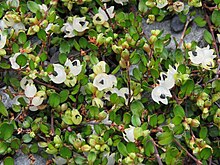|
Muehlenbeckia axillaris
Muehlenbeckia axillaris (creeping wire vine, sprawling wire vine, matted lignum) is a low evergreen shrub, forming wiry mats up to about 1 metre (3 ft 3 in) in diameter, native to New Zealand, and the Australian states of Tasmania, New South Wales and Victoria.[1] It has thin, red-brown stems, with glossy squarish to roundish leaves that are less than 1 cm (0.39 in) in diameter and 2–4 mm (0.079–0.157 in) thick. Flowers are inconspicuous, yellowish-white, 4–8 mm (0.16–0.31 in) in diameter, and borne in groups of up to three in the axils. The fruit is black, shiny, and up to 3.5 mm (0.14 in) long, produced in late summer to fall. The plant is hardy, drought-tolerant, and quick-growing, thriving in a range of light conditions. It can be cultivated as a ground cover and grows well in rocky ground, as well as standard potting soil. Although it grows fastest in warm seasons, it tolerates freezing weather.  TaxonomyThe species was first described by Joseph Dalton Hooker in 1847, who used the name "Polygonum (Muhlenbeckia) axillaris".[2] Both Stephan Endlicher (in 1848)[3] and Wilhelm Gerhard Walpers (in 1849)[4] later referred to it as just Muehlenbeckia axillaris. References
External linksWikimedia Commons has media related to Muehlenbeckia axillaris. Wikispecies has information related to Muehlenbeckia axillaris. |
||||||||||||||||||||||||||||||
Portal di Ensiklopedia Dunia
